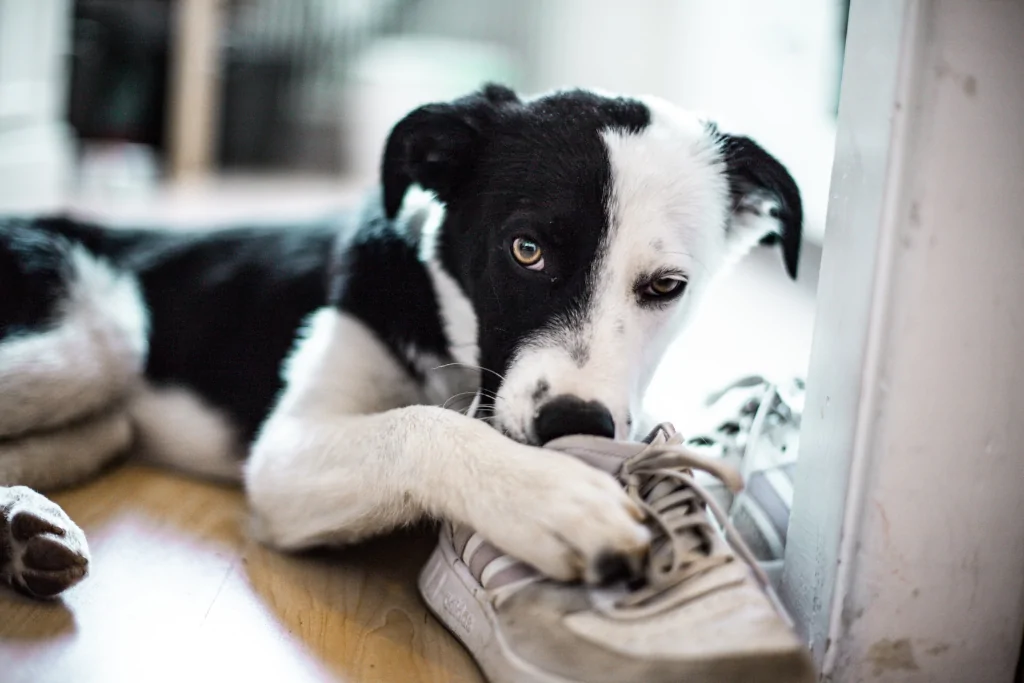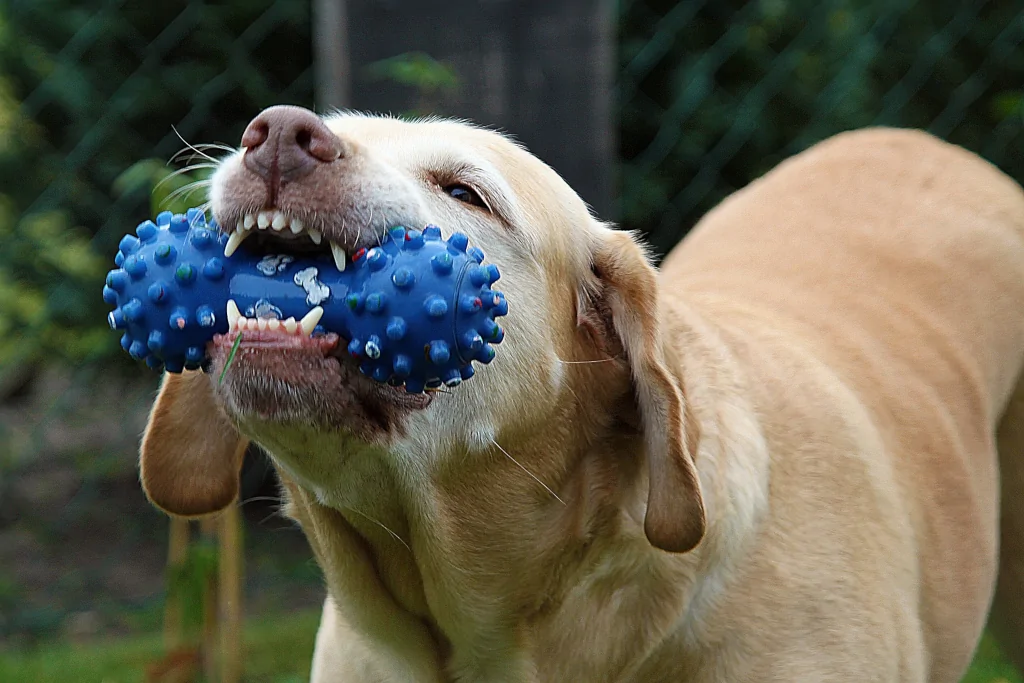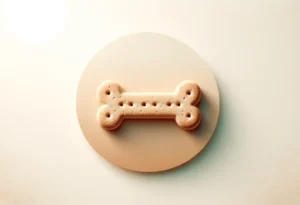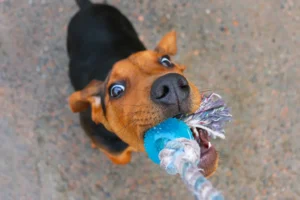Note: We may earn a commission from helpful, relevant links in our content. No cost to you. See our privacy policy.
Have you ever come home to a scene straight out of a horror movie, with your favorite pair of shoes reduced to a pile of unrecognizable shreds?
Or perhaps, discovered your wooden furniture adorned with a new set of chew marks? If this sounds all too familiar, you and your dog are in the right place.
Chewing in dogs can be both a natural and necessary behavior, but when it spirals out of control, it not only wreaks havoc on your home but can also pose serious risks to your furry companion.
I remember in my early days of dog training, one day I returned home from a long day at work, only to find my once pristine living room rug now resembled Swiss cheese, courtesy of my lovely pup. It was in that moment of utter dismay that I realized the importance of taking the reins and helping my dog find a more suitable outlet for his chewing tendencies.
Together, let’s explore the canine world of chewing, from understanding why they do it to finding effective solutions for keeping your belongings – and your sanity – intact.
So, grab your chewed-up shoes and join me as we uncover the secrets to a chew-free, harmonious life with our canine companions.

Why Do Dogs Chew?
Dogs chew for a variety of reasons – it’s an instinctual behavior that serves several purposes.
Chewing helps puppies soothe their sore gums during the teething process, while adult dogs chew to keep their jaws strong and their teeth clean.
Moreover, it’s a natural stress reliever and a way for dogs to combat boredom. Keep in mind that some amount of chewing is normal and healthy for your canine companion.
But worry not, we’ll soon discuss how to differentiate between normal and excessive chewing.
How To Tell if Your Dog’s Chewing Is Normal or Excessive?
To determine if your dog’s chewing habits fall within the normal range or have crossed into excessive territory, pay attention to the frequency and intensity of the behavior.
If your dog occasionally chews on a toy or bone, it’s likely a normal expression of their instincts.
However, if your dog is consistently destroying household items, targeting inappropriate objects (like furniture or shoes), or chewing to the point of harming themselves, it’s time to intervene and address the issue.

Stay tuned as we dive deeper into managing your dog’s chewing behavior in the sections to follow.
Risks of Not Addressing Your Dog’s Chewing Behavior
Ignoring your dog’s excessive chewing can lead to a multitude of problems, both for you and your furry friend.
Unchecked chewing can result in damaged property, which can be expensive to replace. More importantly, it poses health risks to your dog, such as broken teeth, choking hazards, and ingestion of harmful substances or sharp objects.
I remember when my dog chewed on a pair of prescription eyeglasses that I had left on the coffee table. The lenses were shattered, and my dog had some minor cuts inside his mouth. Thankfully, he didn’t swallow any pieces, but it was a close call and a reminder of how dangerous unaddressed chewing can be.
Taking the time to address your dog’s chewing behavior is essential for their well-being and your peace of mind.
The upcoming sections will guide you through practical solutions to help your dog channel their chewing instincts in a healthy and safe manner.
How to Redirect Your Dog’s Chewing to Appropriate Objects
Now that we’ve discussed the risks of unaddressed chewing behavior, let’s explore some effective methods to redirect your dog’s chewing habits toward appropriate objects. This will help your dog stop chewing.
Providing Suitable Chew Toys
One of the most effective ways to redirect your dog’s chewing behavior is by offering them a variety of appropriate chew toys.
Choose toys based on your dog’s size, age, and chewing preferences. Puzzle toys, rubber toys, and dental chews are all great options that cater to different chewing needs.
Rotate these toys regularly to keep your dog interested and engaged, and make sure to replace any worn-out or damaged toys promptly.

Training Techniques for Teaching Acceptable Chewing Behavior
I once caught my dog gnawing on the leg of my dining table. Instead of scolding him, I calmly removed him from the situation and redirected him to a nearby chew toy. When he began chewing the toy, I praised him and gave him a treat.
Positive reinforcement is crucial when teaching your dog what they are allowed to chew on, and I learned a lot about this approach from Sophia Yin’s book, “The Art and Science of Dog Training“.
When you catch your dog chewing on an appropriate toy, praise them and offer a treat to reinforce the behavior. If you find your dog chewing on an inappropriate object, calmly redirect them to an acceptable chew toy and reward them for making the switch.
Here are the exact steps on how to do it:
- Catch your dog in the act of chewing an inappropriate object.
- Calmly interrupt them with a firm but gentle verbal cue.
- Offer an appropriate chew toy as an alternative.
- Praise and reward your dog for making the switch.
With consistency and patience, your dog will eventually learn that chewing on his “chew toys” was a far more rewarding experience.
Creating a Dog-Proof Space
Dog-proofing your home can help prevent your dog from accessing items they shouldn’t chew.
Keep valuable or potentially dangerous items out of your dog’s reach by storing them in closed cabinets or on high shelves.
Use baby gates or playpens to create designated dog-safe zones, and make sure these areas are stocked with appropriate chew toys to keep your dog entertained and satisfied.
Establishing a Routine and Providing Mental Stimulation for Your Dog
A well-structured routine and mental stimulation can do wonders for curbing your dog’s excessive chewing. By keeping your canine companion engaged and entertained, you’ll help them avoid resorting to destructive behaviors out of boredom or restlessness.
Let’s dive deeper into some effective ways to accomplish this, and how you can tailor them to your dog’s unique needs.
Finding the Right Balance of Exercise
Every dog’s exercise requirements vary depending on their age, breed, and overall health. Be sure to provide a healthy mix of physical activities like walking, running, or playing fetch.
Observe your dog’s energy levels and adjust their exercise routine accordingly. Remember, a tired dog is less likely to chew excessively.
For example, I found that taking my dog on a brisk walk in the morning and a leisurely stroll in the evening helped curb his chewing habits. This routine not only improved his behavior but also became a cherished bonding experience for both of us.
Enrichment Activities to Engage the Mind
Incorporate mental stimulation into your dog’s daily routine through enrichment activities. Brain games, scent work, or basic obedience training are great ways to challenge your dog mentally.
You can also try hiding treats or kibble in puzzle toys, which encourages problem-solving and keeps them entertained for extended periods.
I once crafted a homemade snuffle mat for my dog, hiding small treats among the fabric strips. He spent a good chunk of time sniffing and foraging for the hidden goodies, which kept his mind occupied and away from chewing on household items.
Socialization and Doggy Playdates
Arranging playdates with other dogs or enrolling your dog in a daycare can provide essential socialization and mental stimulation. Interacting with other dogs allows your pup to learn appropriate behaviors, burn off energy, and keep their minds engaged.
Be sure to choose playmates with compatible temperaments and monitor their interactions closely. Here’s our full guide on dog socialization.
If, after implementing these strategies, your dog’s chewing habits continue to be a concern, seeking the guidance of a professional dog trainer or behaviorist can be invaluable.
In my case, I enlisted the help of a trainer who taught me how to communicate effectively with my dog and reinforce positive behaviors. Their expertise helped us form a stronger bond and ultimately resolved the chewing issue for good.
By focusing on establishing a well-rounded routine and providing ample mental stimulation for your dog, you’re not only addressing their chewing habits but also fostering a happier, healthier, and more fulfilled canine companion. Check our dog guides for more tips!
Here’s an insightful video from Kikopup on how to train your dog not to bite and chew on your shoes or clothes:
FAQs
Is it normal for adult dogs to chew on things?
It is normal for adult dogs to chew on things as it helps maintain strong jaws and clean teeth, and can also serve as a stress reliever or boredom buster.
Are there certain chew toys that are safer for dogs?
Rubber and nylon chew toys, as well as dental chews, are generally considered safer for dogs, but always choose toys that are size-appropriate and monitor your dog for signs of wear or damage.
How can I stop my dog from chewing on furniture?
To stop your dog from chewing on furniture, provide appropriate chew toys, use deterrent sprays on the furniture, and consider crate training or confining your dog to a dog-proofed area when unsupervised.
Can excessive chewing be a sign of stress or anxiety in dogs?
Excessive chewing can be a sign of stress or anxiety in dogs, as they may use chewing as a coping mechanism to soothe their nerves. Refer to our guides on how to deal with separation anxiety and aggression in dogs for help and resolution of these issues.
Alex, a passionate animal lover, has experience in training and understanding animal behavior. As a proud pet parent to two dogs and three cats, he founded AnimalReport.net to share insights from animal experts and expand his knowledge of the animal kingdom.









